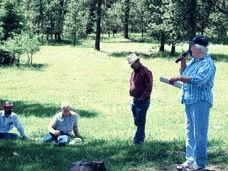CATTLEMEN REVEAL FLAWS WITH STATE WOLF PLAN
Published 12:00 am Monday, July 4, 2005

- NOT IN MY BACKYARD: John Williams and Sharon Beck, with microphone, stood near this open meadow where the Becks graze their cattle and asked the seated crowd to envision the space as wolf habitat under the current Oregon Wolf Plan. (The Observer/MARDI FORD).
Sharon Beck’s gesture encompasses the 360 degree view surrounding the 40 or so people who’ve ridden up Mount Harris to hear a rancher’s perspective on Oregon’s wolf plan.
"Everything you see would be habitat for wolves," says Beck.
Standing firmly beside her are Mack Birkmaier, Joseph, with the Oregon Cattleman’s Association, and John Williams with the Wallowa County Extension Service.
"This is not wolf habitat," she adds as the crowd silently takes in their surroundings.
The view from the small meadow wanders east up the road through the forest and west over the valley floor where La Grande, in the distance, peaks back through the trees.
It’s quiet for a moment while Beck lets the view sink in. Finally, someone in the crowd asks, "You mean they could come down into the valley?"
"Wolves will not be disallowed anywhere," Beck answers.
Until the Oregon Wolf Plan’s population conservation goals of four breeding pairs within the state has been established, she explains, there will be no limits placed on wolf
habitat.
Beck, who represented the cattle industry on the Wolf Plan Task Force, tried to push the incorporation of approved wolf zones into the draft plan, but says her ideas were met with opposition by others on the task force as well as representatives from the Oregon Department of Fish and Wildlife.
Under Oregon’s current endangered species law, it is in violation of that law for anyone who encounters wolves to harass, frighten or harm them in any way.
And therein lies just one of several misconceptions Beck says she wants more Oregonians to understand.
"We’re here to tell you the truth. What you do with it is up to you. But the wolf issue is not a cattlemen’s issue, it’s a public issue. It’s not a plan to manage wolves, it’s a plan to manage people. It’s not about livestock or even liberty it’s about the Republic. We’ve adopted a plan that isn’t even legal," she says.
The Oregon Wolf Plan was adopted by the Oregon Fish and Wildlife Commission with provisions for a disclaimer in empowering legislative changes to Oregon law which as yet have not been written, Beck says. Among them are changes which would allow ranchers to legally take a wolf caught in the act of killing livestock as well as provide them limited compensation for loss.
Without those changes in place first, Beck explains, the plan is worthless to cattlemen.
Other flaws within the plan, Beck told the crowd, involve conflicts between state and federal endangered species laws as well as the species of wolf the plan covers.
The Oregon Wolf Plan details the reintroduction, conservation and management of a federally listed species of Canadian gray wolf, or Canis lupus. The term reintroduction, Beck says, is deceiving because Canis lupus is not, nor has it ever been, native to Oregon. Logically, that makes the Oregon wolf plan an introduction plan, not reintroduction plan. That also makes it illegal under Oregon’s ESA statutes.
"The Oregon gray wolf that was driven out of here decades ago is Canis nubilus," she says a smaller, less aggressive animal than the Canadian gray.
The Oregon gray wolf, or Canis nubilus, is one of several recognized subspecies of the Canadian gray wolf.
"I’ve searched my family diaries and journals dating back to 1892. There’s nothing about these wolves," she says.
The Canadian gray wolf has already made its way north into Montana, Wyoming and Idaho and under the Federal ESA is considered threatened. Under the Oregon ESA, the Canadian gray wolf is considered endangered.
"So when it swims across the Snake River from Idaho into Oregon, under state law it becomes a different wolf. And yet we won’t have the same special tools Idaho has to manage the same wolf," she says.
Beck, who is the first to admit she is not a wolf expert, has talked to hundreds of ranchers in all three states about their firsthand experiences in dealing with wolves.
Even those who have yet to catch a wolf in the act of killing livestock have documented other damage to their livestock cattle, horses and sheep through changes in their behavior.
"They’re frightened. They’re bunching up, raising their heads and constantly smelling the air. It’s a train wreck animals crashing through fences and losing weight. It’s heartbreaking," she says.
Nodding in agreement, Birkmaeir says, "A pack of wolves will chase an animal until it’s exhausted, take it down and then eat it alive. How can anybody defend that? People don’t know a damn thing about this plan. They need to know the truth of what it says and what it means."
" The federal government will manage any wolf that comes into Oregon. We don’t need this plan," Beck says.
Mardi Ford









